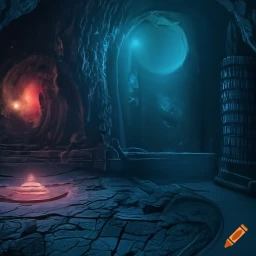What exactly is inside the dungeon? Monsters and treasure, definitely. Some NPCs and treasure, sure. Traps and hazards, of course. And… puzzles.
But puzzles can cause problems. The game grinds to a halt as the DM explains and re-explains an incongruous logic pretzel or goofy riddle. The natural born puzzlers in the group go to work, while the rest of the table checks out.
Even with the best of intentions, people are left behind. In one game where I was a player, our party encountered a puzzle that was an elaborate gag… referencing a TV show that only some of the players in the game had seen. (The GM in question did a great job generally, so I was happy to sit on the sideline in that instance; but the example was still instructive).
By player request, puzzles are part of the mystery of my Knave game, Strangers on a Train, and I have found it’s possible to gradually, slowly, get better at making puzzles. And puzzles are worth keeping in our games.
Tricks, Not Puzzles
Most people know that old-school D&D included instructions for populating dungeons with monsters, treasure, and traps. But new-school D&D players overlook some of the other guidelines for keying the dungeon. Old-school D&D did not suggest (at least not principally) featuring “puzzles” in the sense they are commonly understood today, but rather included “tricks.” The difference is informative.
A puzzle, as typically deployed in RPGs, has one correct answer. There is no partial success. There is no amusing mistake that still moves the scenario forward. There often is not even room to improvise workarounds that bypass the puzzle entirely. Poorly written 5E adventures merely offer a greasy trail of ability checks to give hints to bored PCs until they bump into the right answer.
A trick has no answer because it is not asking questions. It is probably more harmful than helpful to the average PC, but with the tantalizing possibility of lucky benefits or creative leveraging. Because a trick doesn’t have a “right” answer, it’s much easier to plan one. A puzzle, like a joke, needs to have a satisfying conclusion. A trick is more like an amusing non-sequitur that sets the stage for improvisation.
The remainder of this post will talk about puzzles as they’re more commonly understood, but a good time-saving first step is always to ask “could this just be a trick instead?”
Built into the Background
When used poorly, puzzles have the proverbial glowing neon sign pointing to them, announcing their presence. They are “mini-games,” which is to say, a break in the flow of the actual game everyone showed up to play.
A really good puzzle is one the players solve without realizing they’re doing a puzzle. Piecing together the clues to the location of the lich’s phylactery or identifying the murderer may in a sense be a “puzzle,” but if the players solve it purely through asking questions and interacting with the fiction, all the better! The best puzzle is the kind that never announces itself as such.
The Puzzle Pieces
Begin with a collection of related pieces of information. A list can be enough. A dozen animal names. Digits with a non-obvious connection, like ascending prime numbers. A collection of paintings by one particular artist.
Now imagine that someone has access to only a quarter of the list. Could they intuit the pattern, and fill in the rest?
Take this process and phrase it as a question. In its simplest form, it could be “if X, then Y, what comes next?” Or “if you have seven objects with such-and-such characteristics, and seven places to put them, how much information would you need to place all of them correctly (without brute forcing it)?”
The puzzle will feel more natural if the puzzle pieces are not all grouped conveniently around the puzzle itself. The pieces can be bits of information that dungeon residents know. They can be evidence near the crime scene. They can be treasure. They can be pieces of miscellaneous lore or background information that don't fit elsewhere in the game.
After we’ve finished our list of puzzle pieces, we can work backwards to “...why?” Depending on the type of game, this may be easy or difficult. A funhouse dungeon doesn’t really need to explain its puzzles; they’re present because that’s the style of play the players signed up for. But most other games will want more context. Remember, this doesn't have to suggest realism; it simply has to convey verisimilitude, which is to say, it must be true to the shared reality of the game itself.
So why is there a "puzzle" in the game?
- The obstacle has deteriorated from something that used to unambiguously hide or limit access, and can now be "solved" in its weakened state.
- The obstacle includes "clues" that were a reminder for its creator, or an explanation intended for someone else.
- The obstacle is a test to determine worthiness (but be careful with this one, as it's typically overused).
- The obstacle was designed as a game first and foremost, and only later adapted to gate something valuable or useful, probably by an entirely different party from the creator.
- Someone has previously partially solved the puzzle, and showed their work in the process, providing enough information to get started.
- The "puzzle" is an obstacle that is malfunctioning in some way that has subverted its original purpose and made it cryptic and opaque.
- The obstacle's clear meaning and purpose is in a lost language, and the “puzzle” lies in ambiguous translation.
- The obstacle is possessed or guarded by a trickster spirit (such as a mischievous imp or rogue AI) that amuses itself by confounding those who wish to move past it.







